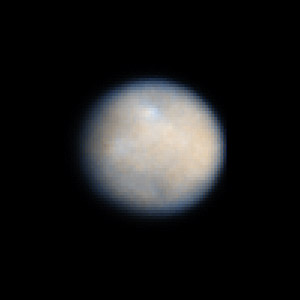[/caption]
Minor planet is a term used to refer to a celestial object – that is not a planet or comet – which orbits the Sun. Found in 1801, Ceres, also known as a dwarf planet, was the first minor planet discovered. The term minor planet has been in use since the 1800’s. Planetoids, asteroids, and minor planets have all been used interchangeably, but the situation became even more confusing when the International Astronomical Union (IAU) committee reclassified minor planets and comets into the new categories of dwarf planets and small solar system bodies. At the same time, the IAU created a new definition of what a planet is, and Pluto was reclassified as a dwarf planet. Hydrostatic equilibrium – the ability to maintain a roughly spherical shape – is what separates dwarf planets from the more irregularly shaped small solar system bodies. The names become even more confusing because the IAU still recognizes the use of the term minor planets.
Minor planets are extremely common with over 400,000 registered and thousands more found each month. Approximately 15,000 minor planets have been given official names while the rest are numbered. When asteroids were first discovered, they were named after characters from Greek and Roman mythology like Ceres was. At first, astronomers thought that the asteroids, especially Ceres and Pallas were actually planets. Astronomers also created symbols for the first asteroids found. There were symbols created for 14 asteroids and some of them were very complex like Victoria’s symbol, which looks like a plant with three leaves growing out of an off center starburst. Soon, astronomers ran out of mythological names and started christening asteroids after television characters, famous people, and relatives of discoverers. Most names were feminine, attesting to an unnamed tradition. As the numbers ran into the thousands, scientists started using their pets as inspiration. After an asteroid was named 2309 Mr. Spock, pet’s names were banned. That did not stop the oddness though because names such as 9007 James Bond and 6402 Chesirecat have been suggested and actually accepted.
There are a number of different categories that minor planets fall into including asteroids, Trans-Neptunian objects, and centaurs. There are various types of asteroids, although most of them can be found in the asteroid belt, which is the region of space between Mars and Jupiter. Trans-Neptunian objects are celestial bodies found orbiting beyond Neptune, and centaurs are celestial bodies with unstable orbits located between Jupiter and Neptune. The categories also overlap, making classifying things a nightmare. For example, Ceres is a dwarf planet and minor planet, additionally it can also be classified as an asteroid.
Universe Today has a number of articles including astronomers find new minor planet and why Pluto is no lone a planet.
You can also check out these articles on asteroids and the solar system.
Astronomy Cast has an episode on the asteroid belt you will want to listen to.
Reference:
Wikipedia

